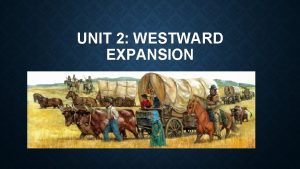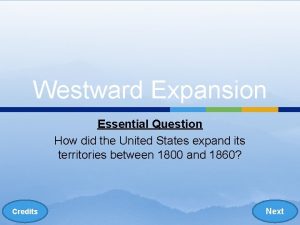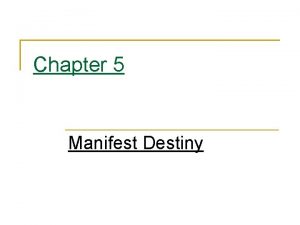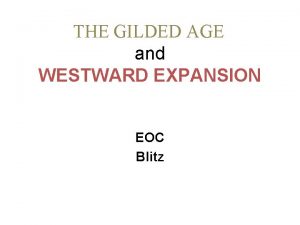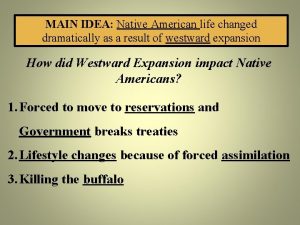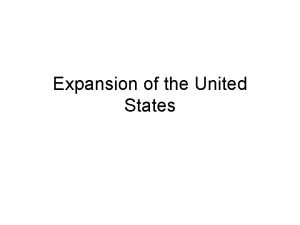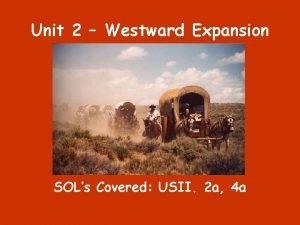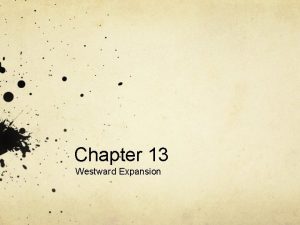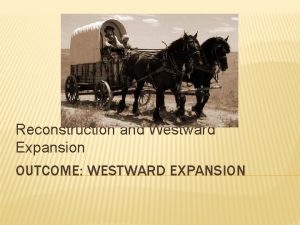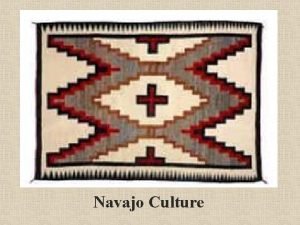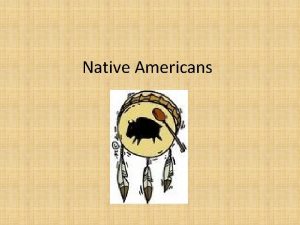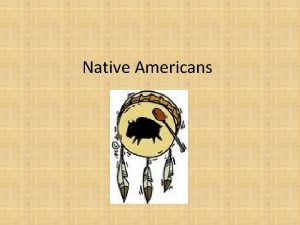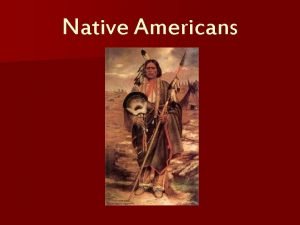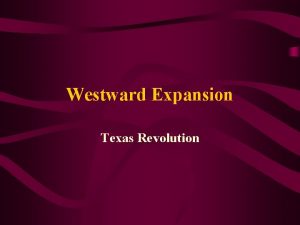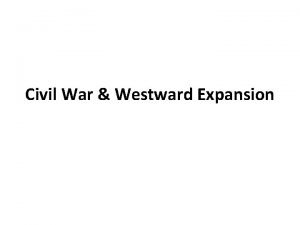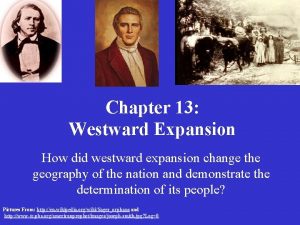Native Americans Westward Expansion Native American Diversity Navajo
















- Slides: 16

Native Americans & Westward Expansion

Native American Diversity Navajo Crow Lakota Sia

Pre-1800 s • Introduction of diseases by Europeans caused widespread epidemics that wiped out up to 80% of some populations. • Conflicts over land claims and overwhelming numbers of Europeans pushed Natives west of the colonies. • The Treaty of Paris (1783) allowed British to hand over many Native Territories to the U. S.

• • • Indian Removal Act (1830) Policy of removing Native Americans from the states “Voluntarily” signed removal treaties Exchanged land in the East for land in the West Signed under President Andrew Jackson Led to the emigration of tens of thousands of Native Americans

Trail of Tears (1838) • Forced relocation of the Cherokee tribe • Georgia Gold Rush (1829) on Cherokee lands led to pressure for removal • Led to 4, 000 Cherokee deaths • Many died from diseases in relocation camps

Manifest Destiny • The U. S. was destined to expand democracy/Christianity to the Pacific Ocean. • Justification for the expansion West.

Assimilation/Americanization • Assimilation - the process whereby a minority group gradually adopts the customs and attitudes of the prevailing culture. • Policies set forth by U. S. government to merge/eliminate tribal traditions with American culture in order to melt Native Americans into the larger society. • Indian Appropriations Act (1851) established reservations throughout

Assimilation • Many religious ceremonies were outlawed.

Assimilation • Children were required to attend English speaking boarding schools. • Forcefully taken from their parents. • Native languages & cultural traditions were banned.

Destruction of the Buffalo • Primary food source for Native Americans on the Plains. • Gov’t. initiative to drive out Natives by depriving them from this food source • Buffalo blocked the progress of trains • Commercial hunting was the main reason for the destruction. • 2, 000 – 100, 000 killed per day

Buffalo

Battle of the Little Bighorn (1876) • Many Native Americans left the reservations • George Armstrong Custer & the 7 th Calvary sent out to corral them back. • Custer was surrounded by Lakota & Cheyenne and was annihilated.

Wounded Knee Massacre (1890) • 7 th Calvary ordered to disarm and escort a group of Dakota Sioux (Lakota) back to the reservation. • Attempted to disarm a deaf tribesman and fire broke out from both sides. • 25 troopers and 153 Lakota Sioux (men/women/children) lay dead.

The Dawes Severalty Act (1887) • Surveyed tribal lands and divided them up into individual allotments for each Native American family. • Natives were registered and given Christian names. • After 25 years the land could be sold, and it was sold to white settlers. • 90, 000 Native Americans were made landless.

Native Culture Fading Away

Closure Directions: - Read the excerpt below and then answer the following questions. “I am tired of fighting. Our chiefs are killed. Looking Glass is dead. Toohoolzote is I am tired of fighting. Our chiefs are killed. Looking Glass is dead. Toohoolzote is dead. The old men are all dead. It dead. The old men are all dead. It is the young men who say, “Yes” or “No. ” He who led the young men who say yes or no. He who led the young men [Olikut] is dead. It is cold, and we have no blankets. The little children are freezing to death. My people, some of young men is dead. It is cold and we have no them, have run away to the hills, and have no blankets, no food. blankets. The little children are freezing to No one knows where they are -- perhaps freezing to death. I death…Hear me my chiefs! I am tired. My want to have time to look for my children, and see how many of them I can find. Maybe I shall find them among the dead. heart is sick and sad. From where the sun now Hear me, my chiefs! I am tired. My heart is sick and sad. stands, I will fight no more forever. ” From where the sun now stands I will fight no more forever. – Chief Joseph’s Surrender Speech: October 5, 1877. What is the Native Americans’ attitude toward fighting Chief Joseph westward expansion at this point? Nez Perce What influence has the policy of assimilation had in establishing this type of attitude?
 American expansion westward/manifest destiny
American expansion westward/manifest destiny Unit 2 westward expansion vocabulary
Unit 2 westward expansion vocabulary Unit 3 rev. statehood and westward expansion
Unit 3 rev. statehood and westward expansion Westward expansion clip art
Westward expansion clip art Westward expansion wagon
Westward expansion wagon Gilded age westward expansion
Gilded age westward expansion Westward expansion vocabulary words
Westward expansion vocabulary words Assimilation westward expansion
Assimilation westward expansion Effects of westward expansion
Effects of westward expansion Westward expansion virtual field trip
Westward expansion virtual field trip Westward expansion territories map
Westward expansion territories map Unit 2 westward expansion vocabulary
Unit 2 westward expansion vocabulary Chapter 13 westward expansion
Chapter 13 westward expansion Gilded age acrostic poem
Gilded age acrostic poem Great plains westward expansion
Great plains westward expansion American historama lewis and clark
American historama lewis and clark Westward expansion lewis and clark
Westward expansion lewis and clark

